This year, Aperture received over one thousand books from fifty-five countries around the world for the Paris Photo–Aperture PhotoBook Awards, an annual celebration of the photobook’s enduring role within the evolving narrative of photography. On September 17–19, 2025, the shortlist jury met in New York for three days of review and deliberation by an international team: Brendan Embser, senior editor, Aperture; Florian Koenigsberger, technologist and photographer; Paul Moakley, executive producer, The New Yorker; Anna Planas, artistic director, Paris Photo; and Keisha Scarville, artist.
The shortlisted books will be exhibited at Paris Photo, open to the public from November 13 through November 16, followed by an international tour, inclu…
This year, Aperture received over one thousand books from fifty-five countries around the world for the Paris Photo–Aperture PhotoBook Awards, an annual celebration of the photobook’s enduring role within the evolving narrative of photography. On September 17–19, 2025, the shortlist jury met in New York for three days of review and deliberation by an international team: Brendan Embser, senior editor, Aperture; Florian Koenigsberger, technologist and photographer; Paul Moakley, executive producer, The New Yorker; Anna Planas, artistic director, Paris Photo; and Keisha Scarville, artist.
The shortlisted books will be exhibited at Paris Photo, open to the public from November 13 through November 16, followed by an international tour, including in New York at Printed Matter, in January 2026, among other venues to be announced. Here is a look inside the thirty-seven selected titles for the 2025 PhotoBook Awards shortlist. Stay tuned for the announcement of the winners, which will take place on Friday, November 14, at 3 p.m.** **at the Balcon de l’Horloge at the Grand Palais.
First PhotoBook
 Eleonora Agostini, from A Study on Waitressing, 2025
Eleonora Agostini, from A Study on Waitressing, 2025
A Study on Waitressing by Eleonora Agostini Witty Books, Turin, Italy, Design by Massimiliano Pace
Eleonora Agostini’s A Study on Waitressing is a timely, multilayered interrogation of the roles that women are asked to play within the regime of self-presentation in the labor market. Agostini approaches this conceptual study by making fictionalized images of a waitress, played by her own mother. The book is divided into six chapters, each featuring a series of staccato-like sequences that layer upon one another ingeniously, narrowing in on mundane details of gesture, movement, and behavior. These visuals are mixed in with semitransparent pages to mark the transition between sections, featuring small, handwritten notes in her mother’s native Italian. Midway through a sequence of cropped close-ups of a woman’s smile, the book shifts to a manual-like text describing how a waitress is to appear, dress, speak, and maintain herself. The phrase “Always Smile While Speaking” is punctuated throughout—a stern reminder that the customer is always right.
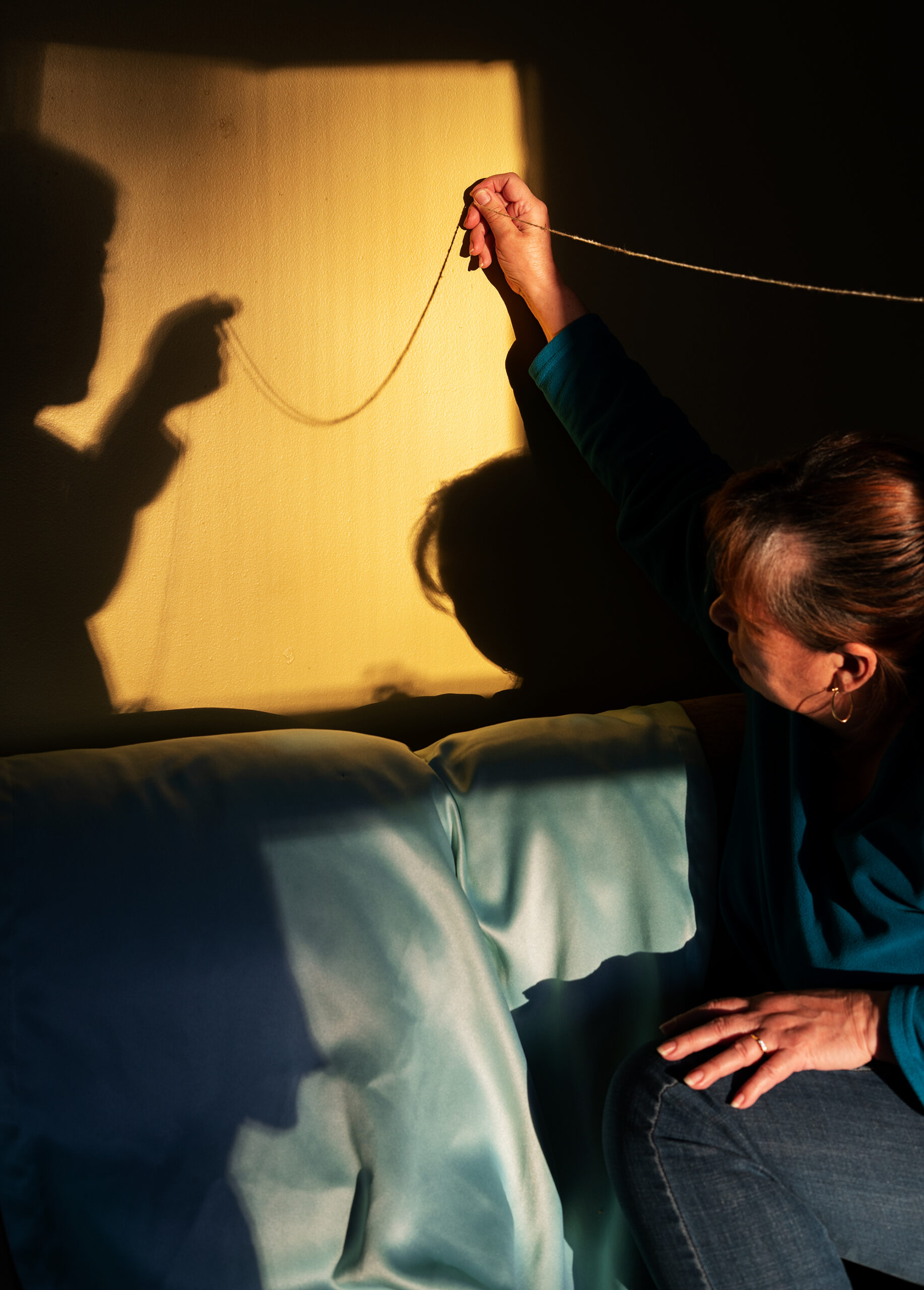 Genesis Báez, Crossing Time / Cruzando el tiempo, 2022, from Blue Sun / Sol Azul, 2025
Genesis Báez, Crossing Time / Cruzando el tiempo, 2022, from Blue Sun / Sol Azul, 2025
Blue Sun / Sol Azul by Genesis Báez Capricious Publishing, New York, Design by Studio Lin
Occasionally, the sun is blue. Seen at the right time, at the right place, light scatters in just the right way to see an atmospheric wonder. Blue Sun / Sol Azul, the first monograph by the Puerto Rican photographer Genesis Báez, is sensitive to how perspective may also be a coincidental wonder. Báez, who was raised in two worlds—the island territory of Puerto Rico and the cold environs of New England—photographs the elemental. Condensation on a window, snow in the field, water contained in a glass jar share the same chemistry. Blue Sun, with its deep azure cover and gold foil-stamped titling on the spine, expertly integrates Báez’s photographs and film stills through alternating paper stocks that provide an intriguing tactile experience. Two essays, one by the artist Elle Pérez, beautifully illuminate a focal point between the natural world and kinship (both texts appear in English and Spanish). Maternal care is shown throughout—the same hands that braid hair, tie knots, also feel how unalike water is here and there, flowing freely on the island and at times frozen in the US. They form the elemental bonds of family.
 Hélène Bellenger, from Bianco Ordinario, 2025
Hélène Bellenger, from Bianco Ordinario, 2025
Bianco Ordinario by Hélène Bellenger Editions de l’Observeur, Vinzelles, France, Design by Hugo Berger and Eleonora Paciullo
For centuries, the marble of the Carrara quarries, located in the Apuan Alps in Italy, has long been sought after by artists and designers for its exceptional quality. But today, the quarries face rapid depletion from the extraction of marble powder—a pure form of calcium carbonate widely used in products ranging from toothpaste, makeup, paper, and cleaning agents, among other items. Hélène Bellenger’s *Bianco Ordinario *draws a link between the history of this region and the powder in the history of whitening, and by extension, the Whiteness of contemporary Western societies. For this project, Bellenger collected the packaging of products that contained calcium carbonate—chewing gum, cosmetics—directly printing photographs of the marble quarries and landscapes onto their exteriors. On first encounter, the book itself is presented within its own individual, screen-printed packaging. The book’s design highlights Bellenger’s typological approach: each page features the individual printed cartons against an off-white background. The rare full-bleed spread reverses this effect, with cutouts of the packaging fragmenting parts of the images—reinforcing Bellenger’s dialogue between the materiality of a place and its ever-present, consumerist flow.
 Wildine Cadet, Seremoni disparisyon #1 (Ritual [Dis]Appearance), 2019, from Ritual [Dis]Appearance / Seremoni Disparisyon, 2025
Wildine Cadet, Seremoni disparisyon #1 (Ritual [Dis]Appearance), 2019, from Ritual [Dis]Appearance / Seremoni Disparisyon, 2025
Ritual [Dis]Appearance / Seremoni Disparisyon by Widline Cadet Black Mountains Studio, Los Angeles, Design by Blake Duncanson and Widline Cadet
“What happens when memory begins to fail for those of us living in the diaspora?” Shanna Jean-Baptiste writes in an essay in Widline Cadet’s *Ritual [Dis]Appearance */ Seremoni Disparisyon, an enthralling visual poem. “Does it lead to disappearance?” In her first book, Cadet, who was born in Haiti, includes staged portraiture and mysterious landscapes, reflecting on what is inherited and what is left behind in the wake of migration. Ritual [Dis]Appearance approaches the fallibility of collective memory through astute design and material choices, particularly the printing of family photographs of wedding and birthday parties on diaphanous velum pages, which allows for the interlayering of past and present like a palimpsest. Throughout, conversations between Cadet and her great aunt—the last person still alive in Cadet’s grandmother’s generation—and her mother and sister create a choral effect of family recordkeeping and revelation. Their exchanges appear in English and Haitian Creole and are reproduced on a deep red, uncoated paper; together, they speak of dreams for the future and dual lives in Haiti and the US. *Ritual [Dis]Appearance *is an outstanding book about what it means to look forward while looking back.
 Daniel Chatard, from Niemandsland, 2025
Daniel Chatard, from Niemandsland, 2025
Niemandsland by Daniel Chatard The Eriskay Connection, Breda, the Netherlands, Design by Carel Fransen
In *Niemandsland *(Dutch for no man’s land), Daniel Chatard combines photographic, cartographic, and archival modes of inquiry to document communities in the Rhineland engaged in a decades-long struggle against energy giant RWE’s opencast mining operations, which have wreaked destruction on Germany’s villages and oldest forests. The book proceeds chronologically, tracing clashes between activists, residents, politicians, and RWE employees, and eventually following displaced residents as they resettled. A growing map of the extractive project introduces each chapter, punctuating stories of the human cost of its so-called progress. Chatard worked on the book for seven years, returning to the same community with book dummies in which he’d pasted his photographs, encouraging people to write on them, as they responded to the images and to what other people wrote. His work therefore functions not only as an elegy or index of something that has disappeared, but also as an urgent document of how local environmental activism plays out on the ground. *Niemansland *is an example, as juror Florian Koenigsberger notes, of “how you investigate the way that place has a profound impact on people’s livelihoods, their survival, and their perspective on the world.”
 Louise Desnos, from Acedia, 2025
Louise Desnos, from Acedia, 2025
Acedia by Louise Desnos Witty Books, Turin, Italy, Design by Ilaria Miotto
Listlessness, melancholia, sloth: These words define Acedia, the title of Louise Desnos’s first photobook. Desnos finds a compelling muse in this historically maligned state, making images in those off-the-clock moments exempt from the pressures of the grind, embracing the serendipity that happens when one lets their attention wander without a clear purpose. The black-and-white and color photographs in her elegant, tightly edited book may seem random—the coiled rind of a citrus fruit, a snail, an embrace between faceless figures, a spoonful of bees—but they cast a powerful spell, offering a seductive riposte to societal norms and whose meanings are at once defiant and appealingly shy.
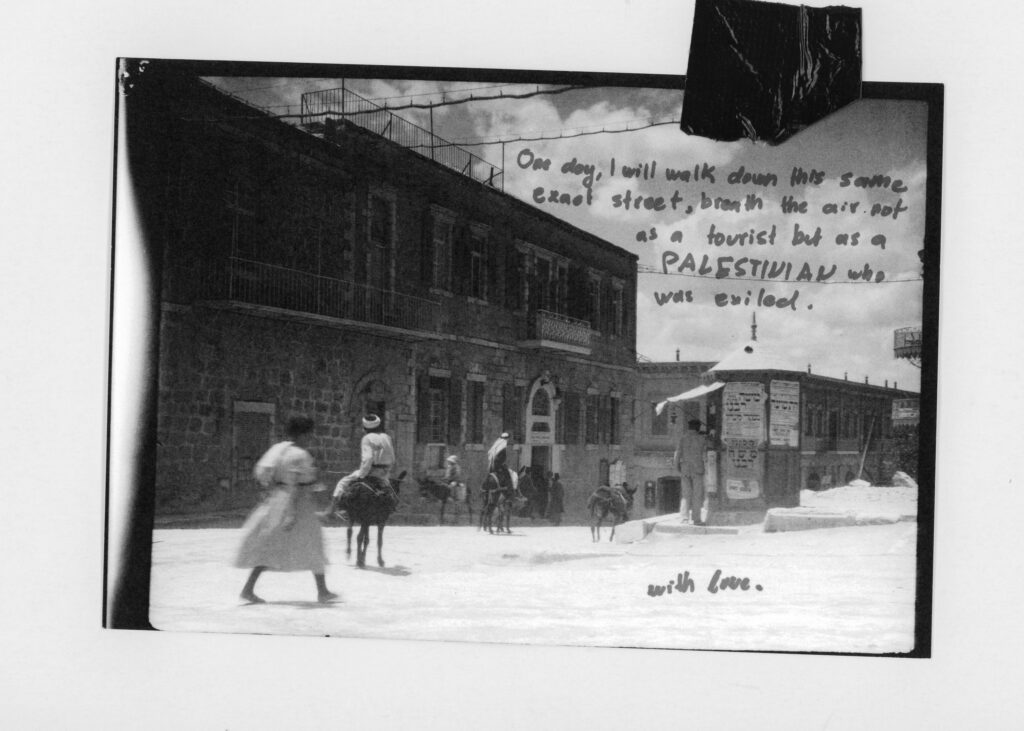 Salome Erni, from Interesting Things, 2025
Salome Erni, from Interesting Things, 2025
Interesting Things by Salome Erni Self-published, The Hague, Design by Salome Erni
Interesting Things examines a cache of fifty-nine photographic negatives from Palestine, originally taken by the Dutch photographer Frank Scholten during his travels to the region in the 1920s. Instead of allowing the images alone to tell the story of Palestine, Salome Erni and her collaborators make written interventions to the original captions. In Erni’s sparse design, which references the texture of an off-white sachet, the colonial baggage of these images exists alongside the preciousness. That these photographs—which depict Palestinian people before the mass displacements of 1948—eventually ended up in the Special Collections Department of Leiden University Libraries in the Netherlands labeled “Des Choses Intéressantes” (Interesting things) is a testament not only to the way that Palestinians have been subject to Orientalism, objectification, and exoticism, but also to the way that Erni has used the photobook medium to find a glitch, however small, in an oppressive political matrix that seems impossible to challenge. “I think we all tend to think of archives as these fixed parts of history that are just like set in stone,” says juror Paul Moakley. “It’s very powerful to see the next generation very clearly engage with a history that is well documented while bringing a new perspective.”
 Alanna Fields, Kiss Me Make My World Fade Away, 2024, from Unveiling, 2025
Alanna Fields, Kiss Me Make My World Fade Away, 2024, from Unveiling, 2025
Unveiling by Alanna Fields Meteoro Editions, Amsterdam, Design by Brian Paul Lamotte
Alanna Fields’s *Unveiling *is an exploration of Black queer identity from the 1920s through the 1990s. After seven years of searching for herself in Black archives with scant results, Fields created veils out of translucent Japanese kozo paper dipped in colored beeswax—with some placed directly on canvas—to convey the subtleties and erasures of being Black and queer in America. The book comprises four of the artist’s projects—As We Were (2019–23), *Audacity *(2020), *Constellations: Our Love Was Deeply Purple *(2021), Mirages of Dreams Past (2021–23)—and features poetry by Sumia Juxun. Unfolding in loose chronological order, the veils slowly become more transparent as we approach the present, a reminder of how time can peel back layers of silence and omission. As the veils thin, what was once obscured begins to emerge, charting a path toward visibility, remembrance, and self-recognition.
 Christine Furuya-Gössler, Untitled (07/04/1980), from Photographs (1978-1985), 2025
Christine Furuya-Gössler, Untitled (07/04/1980), from Photographs (1978-1985), 2025
Photographs (1978–1985) by Christine Furuya-Gössler Chose Commune, Marseille, France, Design by Cécile Poimboeuf-Koizumi and Perrine Serre
Christine Furuya-Gössler entered the photographic canon long ago—not as an image maker but as the recurring muse of her husband, the photographer Seiichi Furuya. Only in 2018 did Furuya discover a trove of unseen color and black-and-white photographs taken by his wife, thirty-three years after her suicide. Her work sat in an attic untouched for decades before being compiled in Photographs (1978–1985), an oblique meditation on marriage, motherhood, travel, memory, and the camera’s gaze (in some images, she appears to photograph her husband just as he’s photographing her). Its front cover graced by a self-portrait reproduced in pale pink, its back cover depicting foaming waves, the softcover volume is sumptuously printed but retains a scrapbook’s intimate feel and pace. While closely intertwined with the oeuvre of her husband, Furuya-Gössler’s photographic life stands alone in this tender and modest presentation as a profound account of an indelible subjectivity, shadowed by the painful fact of its loss.
 Farid Renais Ghimas, Red Kite, from Angan-Angan Harsa, 2025
Farid Renais Ghimas, Red Kite, from Angan-Angan Harsa, 2025
Angan-Angan Harsa by Farid Renais Ghimas Jordan, jordan Édition, Jakarta, Design by Jordan Marzuki
Nostalgia has a speed. In Angan-Angan Harsa, a slim book with a bold, color blocked linen cover and stylish typography, a state of looking back renders the pace of everyday life in Bengkulu, Indonesia, to a near standstill. The photographer Farid Renais Ghimas grew up in Indonesia and left to study abroad in London in 2018. In 2022, he returned for a visit and made a series of incandescent multigenerational portraits of friends, family, and strangers living on the southwest coast of Sumatra Island, all of which are printed full bleed on sheets cut with a grinded-edge finish. These are photographs of the inconspicuous: the sunlit ice cream cone held for dear life against a bustling crowd, the reticulated shadow of a flower ascending, or descending, concrete steps, the soccer ball floating like a crescent moon just beyond a sun-drenched horizon. “The process of capturing these fleeting, mundane, yet joyous moments triggered those visceral memories, transporting me back to those simpler times,” Ghimas recalls. Nostalgia hinges on an acute awareness of the present. All that’s left is a beautiful remembering.
 Mohamed Hassan, Gabal El Mokattam Cairo, from Our Hidden Room, 2025
Mohamed Hassan, Gabal El Mokattam Cairo, from Our Hidden Room, 2025
Our Hidden Room by Mohamed Hassan Ediciones Posibles, Fundación Photographic Social Vision, and Editorial RM, Barcelona; PHREE, Madrid, Design by Brian Carroll
A haunting dialogue between father and son, Mohamed Hassan’s *Our Hidden Room *weaves a sinuous tale about the power of art to make—and withhold—meaning in the aftermath of suffering. Orphaned at a young age, Hassan’s father took refuge in photography while serving in the Egyptian Army. He was eventually discharged due to his struggles with undiagnosed bipolar disorder and, devastated, began to spend more time in his hidden darkroom, opening his own photography business in Alexandria. As Hassan’s father struggled with his mental health, his mother grew increasingly under the influence of the Muslim Brotherhood, condemning her husband’s photography as harem and burning his negatives. In his first photobook, Hassan intersperses his late father’s photographs with his own enigmatic portraits of men and landscapes, offering a simmering meditation on masculinity and family trauma in contemporary Egypt.
 Balarama Heller, Omen, 2019, from Sacred Place, 2025
Balarama Heller, Omen, 2019, from Sacred Place, 2025
Sacred Place by Balarama Heller TIS Books, New York, Design by Balarama Heller, David Schnapper, and Carl Wooley
In 2019, Balarama Heller joined the millions of people who have made the pilgrimage to the Indian town of Vrindavan, said to be the deity Krishna’s childhood home. The trip was deeply personal for Heller, who grew up in (and later left) the Hare Krishna movement in the United States. Across seventy-six full-bleed pages edged in lilac, *Sacred Place *sequences a chain of photographs made in Vrindavan in the hours before sunrise, a time Heller considers the material and spiritual worlds to be at their most permeable. “This book is one of a handful of entries this year that explore things we can’t necessarily see concretely,” says juror Florian Koenigsberger. “It’s still narrative-driven, but the storytelling is open-ended, never didactic.” Images of spectral figures and temples, a ringing bell, barbed wire, nature, and less easily identified phenomena—printed with a radiant attention to color—share a distinctly lambent quality, as though suffused with a mystical aura acquired over millennia.
 Daniel Stephen Homer, L’Observatoire de Haute-Provence, France, 2022, from Route de la belle etoile, 2025
Daniel Stephen Homer, L’Observatoire de Haute-Provence, France, 2022, from Route de la belle etoile, 2025
Route de la belle etoile (Route of the beautiful star) by Daniel Stephen Homer GOST Books, London, Design by GOST
There is something ancient and universal about the desire to gaze up at the night sky. Even in our age of scientific knowledge, where deep space has been probed with imaging satellites and powerful telescopes, the enduring mysteries of the cosmos continue to compel us to look upward. *Route de la belle etoile *(Route of the beautiful star) by Daniel Stephen Homer gazes into a contemporary culture of amateur astronomy in locations around the world and those citizen scientists whose meaningful contributions to academic research often go unnoticed. Homer’s own gaze is reserved and highly formal; he prefers to focus on the geometries of astronomical tools and technology and the architecture of makeshift observatories in backyards. The rich tonal range of Homer’s black-and-white photographs and the textures of ambient light and the dark, nocturnal shadows are sumptuously reproduced on a heavy, coated paper stock. A visual postscript to the plates includes large-format “star glass” annotated negatives of the night sky from Harvard College Observatory. Abstract and mysterious, they evince a parallel spirit of experimentation and wonder.
 Frida Lisa Carstensen Jersø, From Frida Forever, 2025
Frida Lisa Carstensen Jersø, From Frida Forever, 2025
Frida Forever by Frida Lisa Carstensen Jersø Disko Bay, Copenhagen, Design by Spine Studio
Frida Lisa Carstensen Jersø’s life changed forever in 2012, when the young Danish photographer fell from a bridge and broke her back. Rendered paraplegic, she was later diagnosed with a cellular abnormality and subjected to more than one hundred operations. Jersø’s experience in and out of the hospital would become the physical and psychological landscape of Frida Forever, a bracing, clear-eyed chronicle about sickness and survival that never once veers into the realm of despair. In the book, she mixes photographic styles—diaristic close-ups and poised self-portraiture—and in her work broadly, she summons as an inspiration Frida Kahlo, who continued to paint even as she was bedridden due to spinal surgeries. (Their shared first name is a startling coincidence.) The purple leatherette cover is a reference to Jersø’s “purse obsession,” as she notes in memoir-style captions—a purse, which she bought while in the hospital, is seen hanging from an IV trolley as if through X-ray. Some readers may flinch at the depiction of scars and blood, but they serve as proof of existence. “I want people to experience some discomfort when looking at my pictures and to feel an appropriate amount of death anxiety,” she writes.
 Heba Khalifa, from Tiger’s Eye, 2025
Heba Khalifa, from Tiger’s Eye, 2025
Tiger’s Eye by Heba Khalifa Self-published, Waziz Books, Cairo, Design by Nike Dieterich
Heba Khalifa’s book Tiger’s Eye is an act of becoming. The title comes from an insult in Arab culture used to describe a disobedient woman’s gaze. Using a visual narrative centered on Cairo, Khalifa delves deep into her own personal domestic memories through experimental photomontage, journaling, and reworked family photographs to surface and ultimately transmute her repressed pain of sexual assault and silencing. Eyes magnify and multiply; female faces are manipulated and made mirror images of one another. Khalifa’s memory becomes her weapon and her truth. By reconstructing these visual fragments of her past, she creates a space for symbolic healing and self-redefinition. In doing so, Tiger’s Eye becomes a vision of strength—a gaze that dares to shift history and reclaim life. Khalifa is thinking of “a way to push against things that have been placed against her or placed on her,” says juror Keisha Scarville. “There’s an act of liberation that comes up through telling her own story.”
 Mahmoud Khattab, from The Dog Sat Where We Parted, 2025
Mahmoud Khattab, from The Dog Sat Where We Parted, 2025
The Dog Sat Where We Parted by Mahmoud Khattab Self-published, Cairo, Design by Mahmoud Khattab
In 2017, Mahmoud Khattab spent a year in the Egyptian Army as a doctor. The Dog Sat Where We Parted recounts Khattab’s year in national service, weaving together photographs and poetic journal-like entries to create a quiet reckoning with solitude, anonymity, obedience, and the fleeting kinship of military conscription. In the book, the vastness of the desert and Antar, a stray dog who became Khattab’s companion, become central characters and personify the loneliness of being a soldier. The book’s cover is as restrained and contemplative as the interior, depicting a soldier holding a gun in silhouette—alone.
 András Ladocsi, from There Is a Big River, in Which There Is a Big Island, in Which There Is a Lake, in Which There Is an Island, in Which There Is a Small House, Where a Life Is Growing in a Womb, 2025
András Ladocsi, from There Is a Big River, in Which There Is a Big Island, in Which There Is a Lake, in Which There Is an Island, in Which There Is a Small House, Where a Life Is Growing in a Womb, 2025
There Is a Big River, in Which There Is a Big Island, in Which There Is a Lake, in Which There Is an Island, in Which There Is a Small House, Where a Life Is Growing in a Womb by András Ladocsi VOID, Athens, Design by João Linneu and Myrto Steirou
Bodies push against the frame of András Ladocsi’s camera in There Is a Big River. From a tight crop on a newborn’s navel, emphasizing the strangeness of infancy, to a portrait of a man’s face half submerged in water, full figures are never realized, and appendages are reduced to forms and gesture. Photographing friends over the course of six years, Ladocsi pays precise attention to light, color, and direction, creating a beautifully rendered record of collaboration between subject and photographer. A deliberate rhythmic approach to sequencing and a spacious layout with one image per double-page spread allow the compositional quality of the images to shine. Ladocsi cleverly parallels the forms of the body and those found in the natural world, drawing connections between emotion, physicality, and the environment. The softbound cover elevates form and gesture into an emotional, psychological realm.
 Martha Naranjo Sandoval, from Small Death, 2025
Martha Naranjo Sandoval, from Small Death, 2025
Small Death by Martha Naranjo Sandoval MACK, London, Design by Martha Naranjo Sandoval and Morgan Crowcroft-Brown
Who do we become when we leave home? Martha Naranjo Sandoval arrived in New York from Mexico City on August 24, 2014, and met the photographer Justine Kurland the very same day, as Naranjo Sandoval recounts in an afterword to Small Death, the only text in her small but unusually potent first book. A diaristic portrayal of the loss and disruption of emigration, told through strips and isolated frames of Fujifilm 200 35mm color slide film, Small Death is filled with dreamlike self-portraits, surrealistic cityscapes, and revealing images of Naranjo Sandoval’s parents, husband, and siblings. The photographer’s encounter with Kurland proved auspicious and influential: Naranjo Sandoval’s work evinces Kurland’s signature combination of candor and precision, and the bold red cover signals the confidence of arrival.
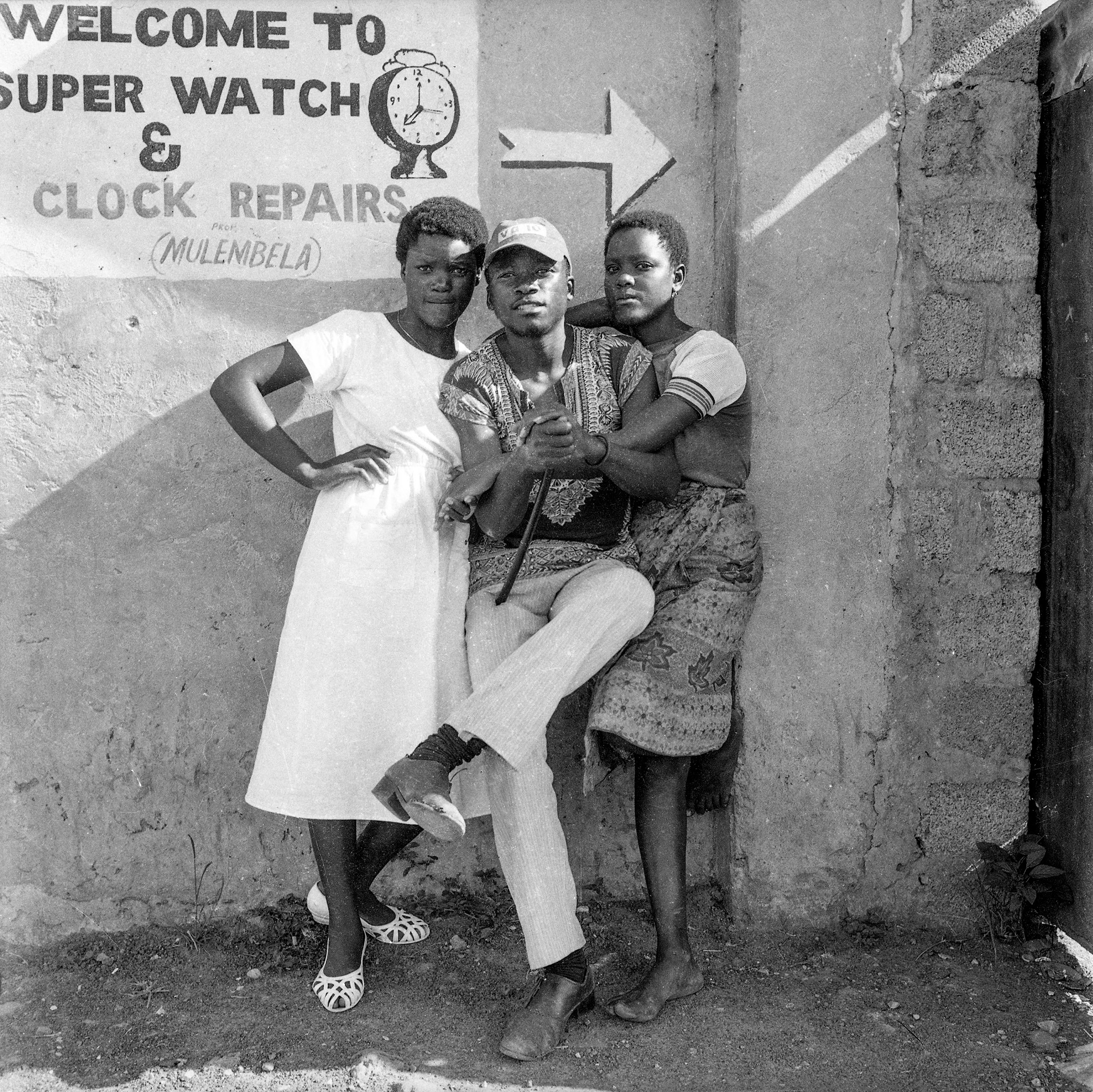 Alick Phiri, from Lusaka Street, 2025
Alick Phiri, from Lusaka Street, 2025
Lusaka Street by Alick Phiri Art Paper Editions, Ghent, Belgium, Design by Jurgen Maelfeyt
The story of twentieth-century African photography is often one of discovery and rediscovery, as archives arrive on the doorsteps of museums or publishers like long lost relatives. Alick Phiri, who was born in Zimbabwe, learned photography as a teenager at Photo Art Studios in Lusaka, Zambia, in the mid-1960s, and continued working there for thirty years. Today, at age seventy-five, he’s one of the few living Black Zambian practitioners from that mid-century heyday of postcolonial optimism, whose archive of black-and-white portraits represents a window onto Zambia’s culture at a moment of social and political transformation. Like Sanlé Sory in Burkina Faso and Jacques Toussele in Cameroon, Phiri had a commercial practice and was attuned to self-styling of his clients, posing many with the street as a backdrop—a “liberated vision” as Sana Ginwalla notes in an essay for Lusaka Street, Phiri’s first book. “His book is a reminder and a response to the historical gaps in how Zambia is remembered,” Ginwalla adds. “It is a call for us to reconsider how we look at the past. A gentle act of revolt in re-remembering.”
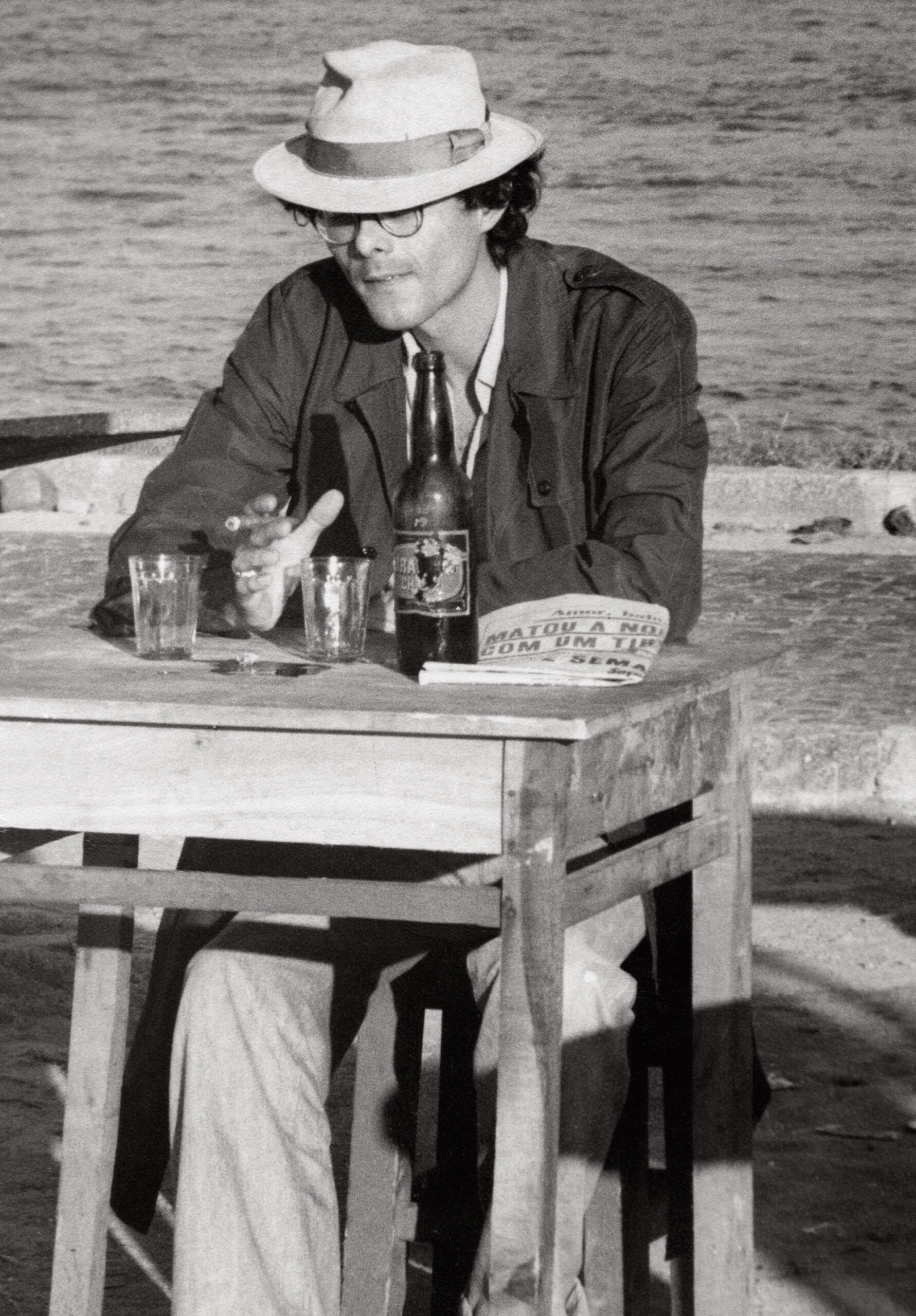 Acervo Manoel Costa, from My father died three times / Meu pai morreu três vezes Propágulo, 2025
Acervo Manoel Costa, from My father died three times / Meu pai morreu três vezes Propágulo, 2025
My father died three times / Meu pai morreu três vezes by Clara Simas Propágulo, Recife, Brazil, Design by Clara Simas and Estúdio Ligatura
Clara Simas’s My father died three times tells stories about Simas’s absent father, who worked as journalist and actor in Bahia’s Cinema Marginal and Pernambuco’s Super-8 Film Cycle during the 1960s and 1970s in Brazil. Images in the book come from different visual sources and are mixed and matched in a hallucinatory way that alternates between documentary and fiction—a kind of visual autofiction—piecing together a fabulated narrative to fill the physical and symbolic void of her father. The book’s trim size evokes a novel, and the repetition of certain images or zoomed-in crops that shimmer in the moiré pattern of analog surveillance stills create the atmosphere of a suspenseful interrogation. Simas includes three as-told-to accounts by her father’s sister, a friend, and his ex-partner, whose voices emerge like narrators in a documentary film, always circling the elusive subject but unable to pin him down.
PhotoBook of the Year
 Hicham Benohoud, from The Classroom, 2025
Hicham Benohoud, from The Classroom, 2025
The Classroom by Hicham Benohoud Loose Joints Publishing, Marseille, France / London, Design by Loose Joints Studio
In the early 1990s, Hicham Benohoud was a jaded high school art teacher in Marrakech. Like his students, who came from underprivileged backgrounds, he felt trapped by the stultifyingly rigid power structures of postcolonial Morocco. So he started to improvise photoshoots to pass the time, transforming his four-hour class into a site of joyful photographic ingenuity and hands-on learning. Made between 1992 and 2002, the black-and-white photographs of The Classroom show Benohoud’s pupils posing against makeshift backdrops and behind paper cages, at desks stacked atop other desks, with Hula-Hoops and in surreal outfits crafted with long cardboard tubes or plastic bags, their faces often playfully obscured. “This book stopped me in my tracks,” says juror Florian Koenigsberger. “Above all, I’m attracted to the resourcefulness of the work. I think it’s a model for creativity in a lot of ways, of making the most of what you have. It offers a beautiful perspective on imagination.”
 Soumya Sankar Bose, from A Discreet Exit Through Darkness & Things We Lost Last Night, 2025
Soumya Sankar Bose, from A Discreet Exit Through Darkness & Things We Lost Last Night, 2025
A Discreet Exit Through Darkness & Things We Lost Last Night by Soumya Sankar Bose Self-published / Red Turtle Photobook and Mandas, Kolkata, India, Design by Barnali Bose
Ambitious and compelling, A Discreet Exit Through Darkness & Things We Lost Last Night recasts a harrowing family mystery: the disappearance of Soumya Sankar Bose’s mother in 1969 and her unexplained return years later. A veteran film director, Bose, who is based in Kolkata, India, presents two distinct perspectives to narrate his story—diary entries from his grandfather’s searching for his missing daughter and recorded narratives from his mother’s fractured memories. (An insert for the book includes the texts in Bengali.) Designed to be flipped over and read beginning from two different covers, the structure cleverly mediates the dual perspectives. Bose’s photographs convey fluency in multiple visual grammars—staged portraits, haunting landscapes, interventions with vernacular family photos—all united by a dark, unflinching attention to narrative and atmosphere. Interweaving text and image, A Discreet Exit is a riveting, fraught, and innovative account of family trauma and its generational reverberations.
 Pippa Garner, from Personal Ads, 2025
Pippa Garner, from Personal Ads, 2025
Personal Ads by Pippa Garner Art Paper Editions, Ghent, Belgium, Design by Jurgen Maelfeyt
The late Pippa Garner made a career of playfully incisive works that challenged the boundaries of consumer culture and gender identity. Personal Ads is an exploration of the artist’s ability not only to reimagine but also to interrogate the structures of our everyday lives. The volume draws from Garner’s archive of photographs, bringing together candid snapshots, editorials, and performance documentation that foreground her distinctly subversive vision. “I was just taken by the book immediately, this retro sensibility that feels like the style of photography that a lot of photographers are referencing right now,” says juror Paul Moakley. A wry sense of humor and lightness is seen across the book and especially in its design, reflected most prominently in the bright purple cover complete with a demure but fanciful script for the title. *Personal Ads *also serves as a reminder that fashion can be a vehicle for personal and political expression. “If Garner sees fashion as a language for customizing the body and expanding the limits of gender, art is a means of communication,” writes the editor Giorgia Basch, “and as such it encapsulates both self-assertion and a vision of the world outside the self.”
 Pia-Paulina Guilmoth, from Flowers that Drink the River, 2025
Pia-Paulina Guilmoth, from Flowers that Drink the River, 2025
Flowers Drink the River by Pia-Paulina Guilmoth STANLEY/BARKER, London, Design by ramel·luzoir
Under the moonlight, in the dark cover of the night, Pia-Paulina Guilmoth guides us into a nocturnal dreamscape that reveals the beauty and resilience born from transformation. Flowers Drink the River spans the first two years of Guilmoth’s gender transition, when she began photographing her community in rural Maine, exploring both the joy and terror of life as a trans woman in a small right-wing town. Using a large-format camera and a heavy flash, Guilmoth oscillates between the mystical and ominous, and each frame feels as if it’s a small moment captured mid-ritual, leaving us to imagine what transpires outside the frame. Spiderwebs and moths sparkle against darkness; mud-drenched bodies intertwine in fields; and landscapes shimmer with an almost ethereal haze. Flowers Drink the River blends Guilmoth’s mystical yet exacting view upon her own search for resistance, magic, and safety in a world often devoid of it.
 Katherine Hubbard, from The Great Room, 2025
Katherine Hubbard, from The Great Room, 2025
The Great Room by Katherine Hubbard Loose Joints Publishing, Marseille, France / London, Design by Loose Joints Studio
The Great Room is an elegiac meditation on the nature of care, memory, and grief. In 2020, Katherine Hubbard’s mother began experiencing severe memory loss and was diagnosed with LATE, a brain disease that mimics the symptoms of Alzheimer’s. This began an ongoing collaboration with her mother, in which their daily routines (such as bathing, organizing, watching television) transform into layered black-and-white scenes. As a result, a tense, almost psychological air fills Hubbard’s large-format photographs, which resist the boundaries of documentary or staged photographs, instead quietly entangling both the real and the performed. Mirrors are an ongoing motif, allowing Hubbard to simultaneously insert herself into the images while placing an irrevocable distance between mother and daughter—and, by extension, past and present. “Hubbard has a really beautiful way of dissecting and thinking about the psychology of something,” notes juror Keisha Scarville. The radical softness throughout *The Great Room *envisions the home as a space where photography can reimagine the slow grief of dementia into a powerful act of preservation and love.
 Edgar Martins, from Anton’s Hand Is Made of Guilt. No Muscle or Bone. He Has a Gung-Ho Finger & a Grief-Stricken Thumb, 2025
Edgar Martins, from Anton’s Hand Is Made of Guilt. No Muscle or Bone. He Has a Gung-Ho Finger & a Grief-Stricken Thumb, 2025
Anton’s Hand Is Made of Guilt. No Muscle or Bone. He Has a Gung-Ho Finger & a Grief-Stricken Thumb. by Edgar Martins The Moth House, Bedford, United Kingdom, Design by Pedro Falcão
In 2011, the South African and Austrian photojournalist Anton Hammerl was killed by government forces while on assignment covering the First Libyan Civil War. Fourteen years later, the photographer Edgar Martins, a close friend of Hammerl’s, reconciles this past and the traumatic aftermath to create a poignantly complicated, highly researched, and sardonic inquiry into the purpose of documents. *Anton’s Hand Is Made of Guilt *comprises two books (one of which houses drawings inscribed on a facsimile of Muammar Gaddafi’s Green Book), and one album of soundscapes that together trace a search for meaning with no clear-cut answers. Tightly cropped, oblique images of mutilated bodies are buffered by expansive white borders, charcoal drawings, and screenshots of pro-Gaddafi Facebook posts that intervene against the appearance of vivid reportage. Emanating from this tripartite volume is an incredulous argument for photography—only one in which closure and the declarative is withheld.
 Jorge Panchoaga, from Kalabongó, 2025
Jorge Panchoaga, from Kalabongó, 2025
Kalabongó by Jorge Panchoaga Editorial RM and Paloma Ediciones, Spain, Design by Estudio Herrera and Jorge Panchoaga
As the story goes, the first free people who founded San Basilio de Palenque, Colombia, were guided there by light of fireflies. Home, freedom, was found in the dark of night. Nighttime has always been a wellspring for the narrative. How many stories are first fleshed out around a campfire? Kalabongó (the Palenquero word for fireflies) is a visually resplendent book that incorporates folktales, firsthand memories, and portraits of descendants of those first free people who escaped slavery in the seventeenth century. Working with the community, the Colombian photographer Jorge Panchoaga brings together striking images that highlight the nonliteral or incongruent, those mysterious inflections that summon the magic thread of story. Richly printed paper in witching-hour red blinds the eye after extended viewing. Something is seen after the book is put down, an afterimage, or is it flame, the light of freedom?
 Bharat Sikka, from Ripples in the Pond, 2025
Bharat Sikka, from Ripples in the Pond, 2025
Ripples in the Pond by Bharat Sikka Fw:Books, Amsterdam, Design by Hans Gremmen
Bharat Sikka’s record of collaboration with the Dutch designer Hans Gremmen has been nothing short of superb—and *Ripples in the Pond *represents another triumph of the photobook as a form and object. A kaleidoscopic sequence of sepia-toned photographs loosely explores Makharda, a township on the outskirts of Kolkata, India, and surrounding landscape, which includes numerous ponds. Reflections are both a leitmotif and a strategy for Sikka—images of water reappear throughout the sequence, but he also utilizes a scanning strategy that distorts and fragments images as if looking through an old television screen. In these manipulations, Sikka references Malgudi Days, a TV show from the 1980s that focused on the small dramas of community life. Textural, stylized, and exquisitely printed, Sikka delivers another layered, riveting experiment.
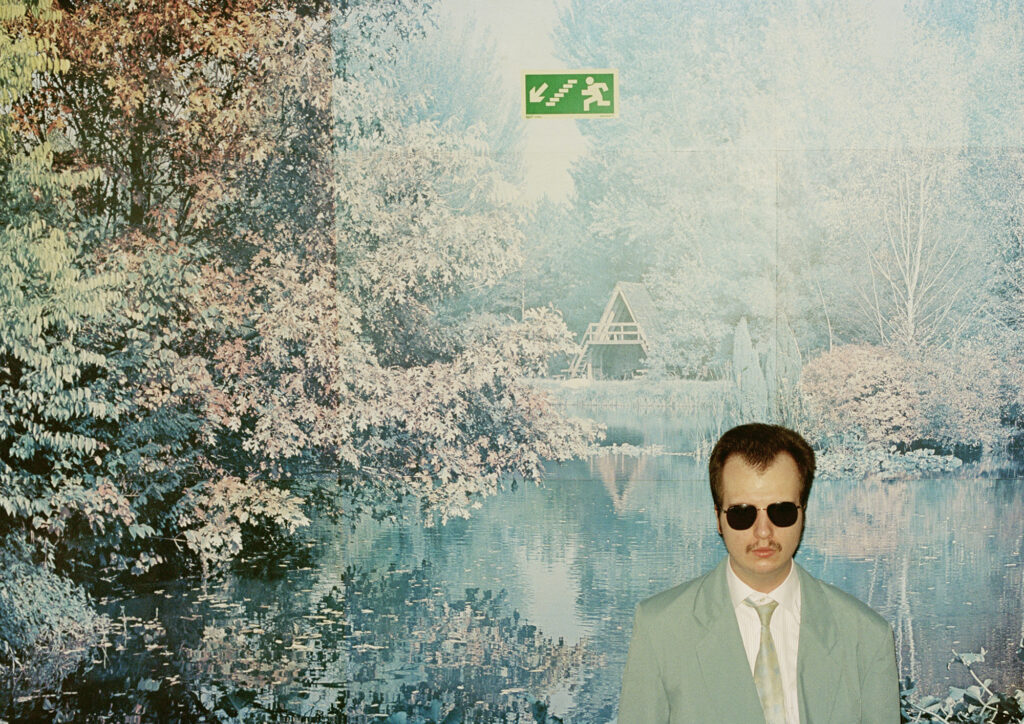 Éva Szombat, from Echo in Delirium, 2025
Éva Szombat, from Echo in Delirium, 2025
Echo in Delirium by Éva Szombat Symposion and Everybody Needs Art, Budapest, Design by Anna Bárdy
Wacky and irreverent, *Echo in Delirium *takes on the kitsch, trends, and ersatz goods of 1980s and ’90s pop culture to create a book that feels like a fever dream of a bygone era. A zany, accordion-fold cover reveals a small, spiral-bound book-block in which vibrant color images are printed full bleed on uncoated paper. Foldouts wryly labeled “Open Here” reveal larger landscapes. Most of Szombat’s photographs are delightful observations of cultural remnants from public space and domestic interiors—a set of doors has been decaled with a surreal Mr. Bean montage, or a life-size Terminator figurine stands awkwardly in the corner of a room. “This book is delivering humor, which is so necessary to all of our lives,” observes juror Paul Moakley. “The sense of humor is really matched by the design.” By making us look and look again, Szombat reveals the irony in these repetitions, pastiches, and echoes of our lingering cultural obsessions.
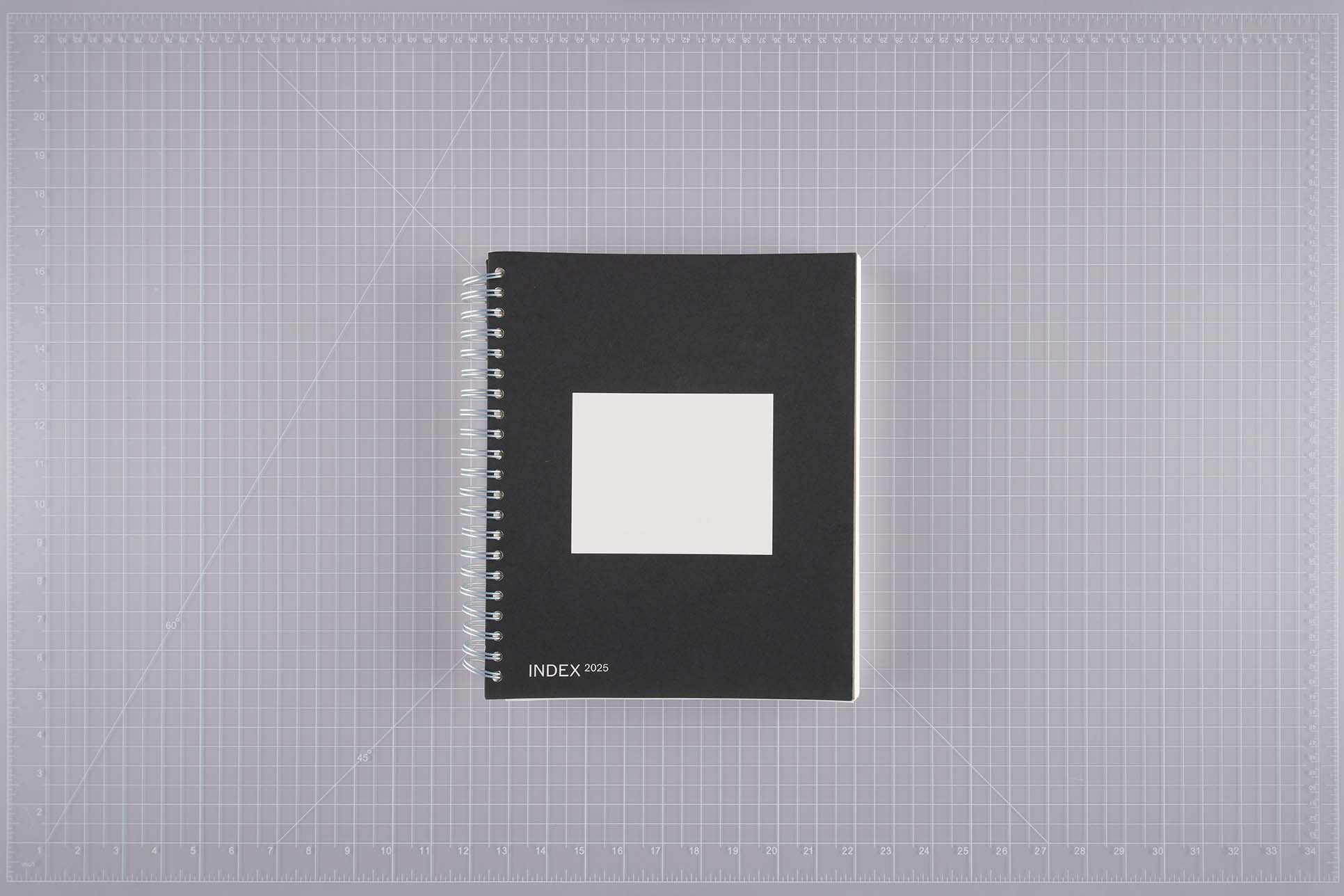 Cover of *INDEX 2025 *(Roma Publications, 2025) by Stanley Wolukau-Wanambwa
Cover of *INDEX 2025 *(Roma Publications, 2025) by Stanley Wolukau-Wanambwa
INDEX 2025 by Stanley Wolukau-Wanambwa Roma Publications, Amsterdam, Design by Roger Willems
The spiral-bound INDEX 2025, by the peripatetic writer and photographer Stanley Wolukau-Wanambwa, is a scholastic riddle. Like any good one, the book draws its energy from possibility, the potential that answers may come into existence from an unassuming set of clues: 122 works, 105 titles, 247 reproductions, and 11,639 words that at first glance repeat, annotate, and reference themselves nonsensically. Halfway through, a list of names, years, titles, venues, cities, and countries is given stage business: the work that these citations constitute and enshrine is not entirely present. What’s here instead is a suite of subscript words defining exquisitely mundane black-and-white photographs that appear to resist definition: a garage door in Boston, a statue in Virginia, a typewriter in Rhode Island, a brick wall in London. “It’s a book that’s really meant to be read page by page,” notes juror Anna Planas. “A book that reveals itself slowly through the use of images, the use of repetition.”
Photography Catalog of the Year
 Frances Gqoba, The African Choir, London, 1891
© Hulton Archive/Getty Images
Frances Gqoba, The African Choir, London, 1891
© Hulton Archive/Getty Images
Black Chronicles: Photography, Race and Difference in Victorian Britain, Edited by Renée Mussai Thames & Hudson and Autograph, London, Design by Fraser Muggeridge Studio
Black Chronicles is the culmination of an expansive research project, initiated by Autograph, a London-based institution focused on photography’s relation to race and social justice, that reveals Black lives in nineteenth-century Britain through an astonishing array of studio portraits. But the book, according to the curator and editor Renée Mussai, is decidedly not a traditional catalog or historical survey. “It is a re/orienting ‘gathering’ of archival images from the past, reconstituted in the aliveness of the present,” she writes in the book’s introduction. The design privileges the intensity of gazes between photographers and subjects through outstanding reproduction, which also allows for clothing, jewelry, and hairstyles, and the writing on cartes-de-visite and album pages to be visible with a startling clarity of detail. Since 2014, various exhibitions of Black Chronicles have traveled around the world, and the photographs have always been presented against a matte-black background, as though emerging from a dark archive, and complemented by quotes and commentary in large white letters—a scholarly yet interrogative method carried into the book, with its cocoon-like atmosphere amplified by the black-dyed edges of the paper. Mussai’s meticulous biographical notes on numerous sitters are an immense and compelling resource, but she adds that many are still “not-yet-identified,” meaning there is more work to be done. History, as *Black Chronicles *vividly illustrates, is constantly under revision.
 Petra Stavast Mullers, April 2016, from Calamita/á: An Investigation into the Vajont Catastrophe, 2025
Petra Stavast Mullers, April 2016, from Calamita/á: An Investigation into the Vajont Catastrophe, 2025
Calamita/à: An Investigation into the Vajont Catastrophe, Edited by Gianpaolo Arena and Marina Caneve Fw:Books, Amsterdam, Design by Hans Gremmen
A horrific environmental disaster is the subject of Calamita/à: An Investigation into the Vajont Catastrophe, a book about the hubris of man and the power of nature. On October 9, 1963, a landslide into a lake formed by a hydroelectric dam on the Vajont River, in northeastern Italy, caused a megatsunami, pouring more than sixty million cubic meters of water into the Piave Valley with a shockwave force of two atomic bombs. Entire villages were instantly erased, and some two thousand people were killed. The Italian government was blamed for negligence, having ignored reports of unstable rock in the region of the dam. But this information comes at the end of Calamita/à, the culmination of an ambitious, multidisciplinary research inquiry launched in 2013 by Gianpaolo Arena and Marina Caneve, who sought a “collective vision” through a network of photographers and writers. The book opens with a prose poem and steers the reader through numerous portfolios that document the Vajont area today, with digressions into archival images and news reports, all in the service of reinscribing the catastrophe into public memory—and alerting us, as the editors write, to “the arrogance of the ruling class, the cowardly silence of the press, and the vain search for justice.”
 Donna Gottschalk, from Nous Autres, 2025
Donna Gottschalk, from Nous Autres, 2025
Donna Gottschalk and Hélène Giannecchini: Nous Autres (We Others), Edited by Nathalie Chapuis and Camille Cibot Atelier EXB and LE BAL, Paris, Design by Coline Aguettaz
*Nous Autres *(We Others) is the first monograph of the American photographer Donna Gottschalk, who, from the late 1960s to 1990, photographed in Alphabet City, the bohemian downtown neighborhood in New York. Pictures of sparse storefronts, beauty salons, and dilapidated or boarded-up buildings not only give record to a New York vanished to time but also serve as a backdrop to an intimate, personal archive. The clarion immediacy of Gottschalk’s portraits lend visibility to the lesbian, trans, and gay rights activists who gave life and blood to the 1970s LGBTQI+ movement. But as an essay, written by Hélène Giannecchini in conversation with Gottschalk, makes clear, these young activists were also friends, family, and lovers. “You see all of these beautiful moments of community and coming together,” juror Paul Moakley notes, “but you’re also seeing the more intimate side of life.” As a dialogue between word and image, the biographical narrative and photographs provide insight to a burgeoning political movement but one seen from its private quarters—late mornings in bed, recumbent afternoons, and nights brimming with possibility.
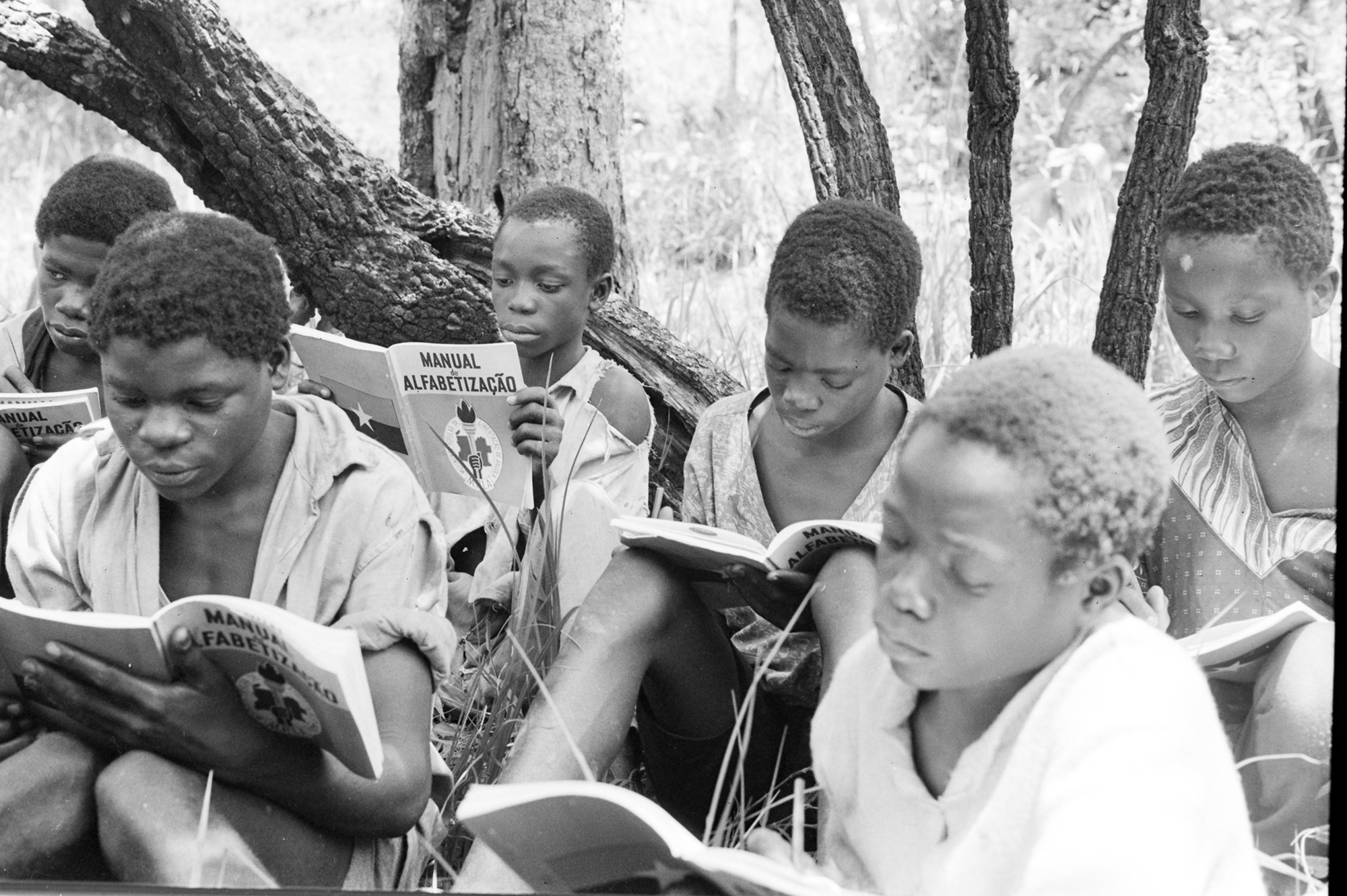 Augusta Conchiglia, from Generalized Visual Resistance: Photobooks and Liberation Movements, 2025
Augusta Conchiglia, from Generalized Visual Resistance: Photobooks and Liberation Movements, 2025
Generalized Visual Resistance: Photobooks and Liberation Movements, Edited by Catarina Boieiro and Raquel Schefer ATLAS, Lisbon, Design by Teo Furtado and Ana Schefer
“The history of photobooks looks different from the vantage point of the African continent,” Drew Thompson writes in Generalized Visual Resistance: Photobooks and Liberation Movements, a vigorous anthology about the links between photography and anticolonial politics from the 1960s to the 1980s, when Portugal’s former colonies in Africa fought for independence. The product of a research initiative begun in 2018—with texts in English, French, and Portuguese—this book spotlights organizations such as the Front for the Liberation of Mozambique (FRELIMO), which was instrumental in producing photobooks wielded by activists to inspire international solidarity. Covers and spreads from rare publications are reproduced throughout, displaying an immense range of visual communication strategies that often put a premium on dramatic, high-impact images, and showing how politically motivated publishers in Maputo, Mozambique, as well as Amsterdam, Moscow, San Francisco, and Tokyo, envisioned Africa’s freedom and self-determination.
 Éamonn Freel, 2024, from The Lure of the Image, 2025
Éamonn Freel, 2024, from The Lure of the Image, 2025
[The Lure of the Image](https://www.spectorbooks.com/book/the-lure-of-t